1920 - 1972
Artist, collector and teacher
Edward Albert 'Douglas' Watson was a portrait and landscape artist and lecturer. At 22, he won The Wynne Prize and in 1943 became Australia’s youngest official WW2 artist. In his career spanning less than three decades, Watson created hundreds of works that remain in the collections of major Australian institutions.
Image: Australian War Memorial 0794696. Lieutenant E. A. D. Watson, War Artist, Military History Section attached to headquarters, New Guinea Force. Milne Bay, New Guinea, 19 July 1944.
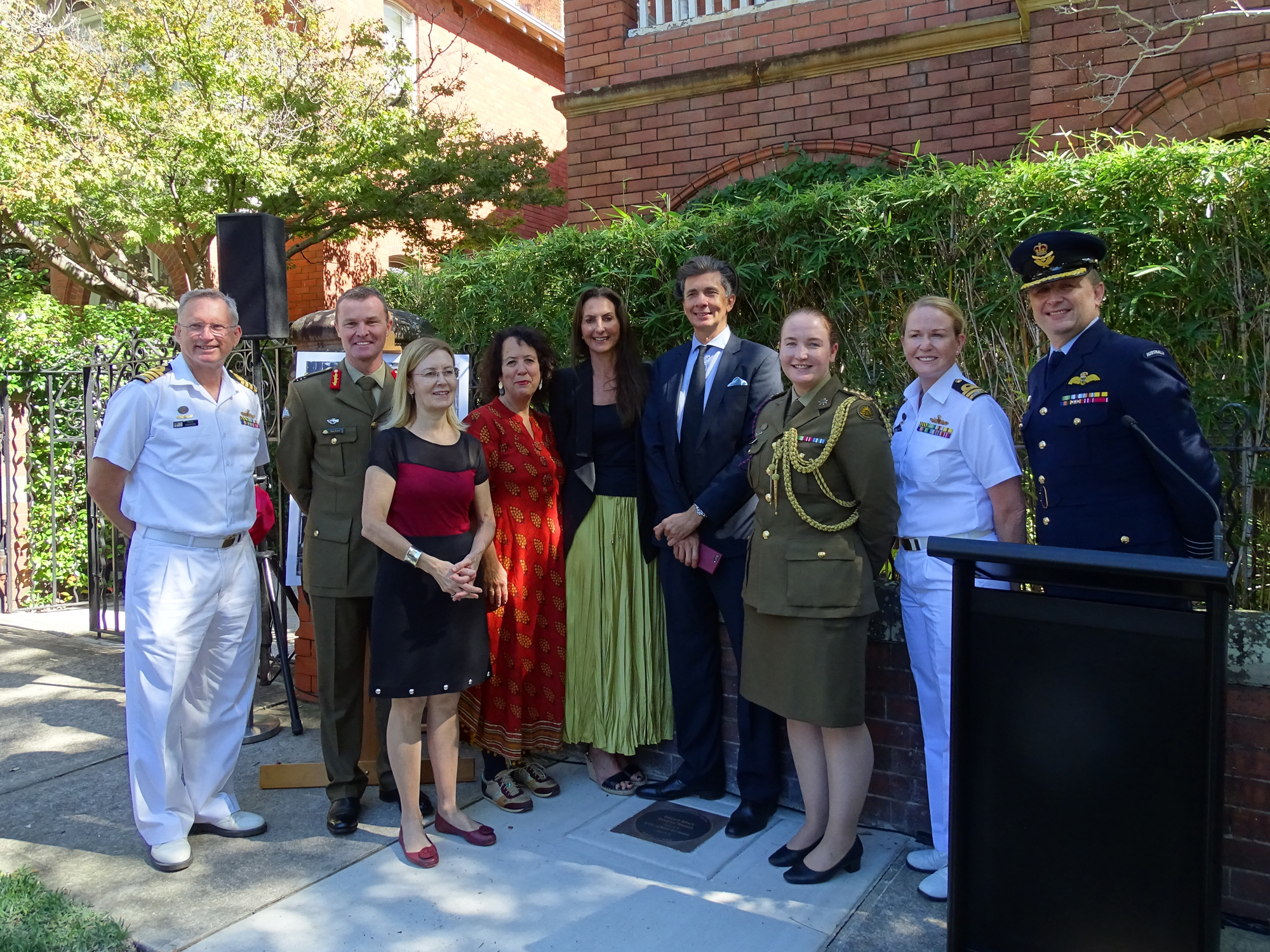
Plaque unveiling for E A ‘Douglas’ Watson at 39 Etham Avenue, Darling Point 14 April 2021. L-R Captain Heath Robertson, Major General Matt Pearse, AM, The Hon. Gabrielle Upton, MP, Wendy Sharpe, Mayor Cr. Susan Wynne, Cr. Anthony Marano, Staff Officer Amy Duncan, Commander Tina Brown, Group Captain Michael Jansen.
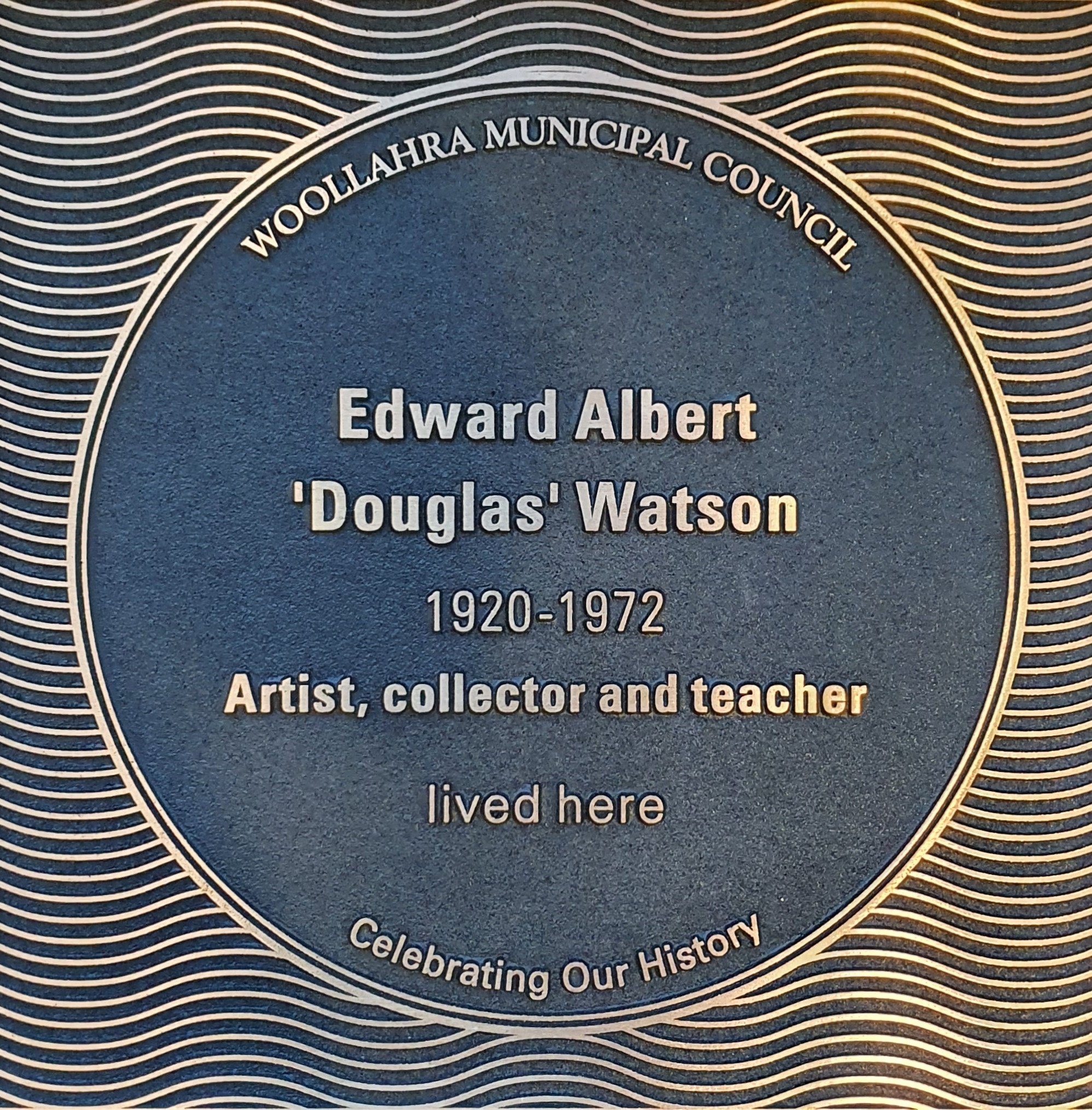
>A plaque commemorating E A Douglas Watson was unveiled on 14 April 2021. The plaque is located on the footpath outside 39 Etham Avenue, Darling Point, the home Douglas Watson shared with his sister Madge from c1958 to 1972.
Watch the plaque unveiling video
Gallery
L-R Captain Heath Robertson, Major General Matt Pearse, AM, The Hon. Gabrielle Upton, MP, Wendy Sharpe, Mayor Cr. Susan Wynne, Cr. Anthony Marano, Staff Officer Amy Duncan, Commander Tina Brown, Group Captain Michael Jansen.
(JPG, 2MB)
E A 'Douglas' Watson (13 June 1920 – 17 October 1972)
Edward Albert Douglas Watson was a portrait and landscape artist and lecturer, winner of The Wynne Prize in 1943 and 1945, and in 1943 became Australia’s youngest official WW2 artist.
Douglas Watson’s great appetite for all the arts was matched by his deep knowledge and a miraculous memory; his eagle eye missed nothing in a gallery, a sale-room or junk shop; he was a discerning and bold collector and could make Primitive and Empire live together.
Charles Bush, 1973i
E A Douglas Watson was the youngest child of Annie and Albert Alexander Watson, born in Canterbury, NSW on 13 June 1920. He had three siblings: Madge (born 1909), Alexander (born 1911), and Lorna (born 1913). Albert Watson worked for the New South Wales Public Service. He served as the Chairman of the Milk Board and from 1920 as the Director of New South Wales Soldier Settlements, a position he held for seven years. As a child and young adult, Douglas loved tennis, music and reading. He carried these loves throughout his life and would remain close to his oldest sister Madge, with whom he later purchased a house in Darling Point, filling it with books and art.
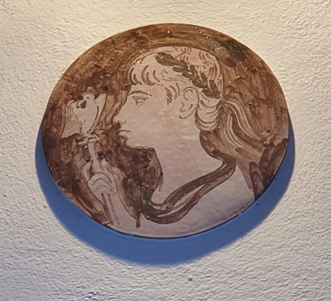
Plaque above the front door at 39 Etham Avenue, Darling Point, painted by Douglas Watson.
Education
Douglas was educated at his local school, Canterbury Primary School, followed by three years at Sydney Grammar School. His intrinsic artistic abilities became apparent at an early age and he would excel as a young man, winning several examinations, medals, and awards early in his career.
In 1935, Douglas enrolled as a student for the Painting Diploma in the Art Department of East Sydney Technical College. For his first year Diploma Examination, Watson won a competition entitling him to free examination fees. Watson received his Diploma with Honours at examinations in 1939. That same year, he also won the Bronze Medal awarded by the College for Painting. Watson spent 1940 attending Drawing and Life Modelling Classes at the East Sydney Technical College in post-diploma work.
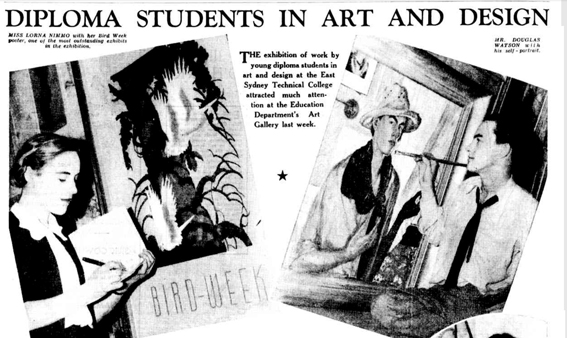
'Diploma Students in Art and Design'. Sydney Morning Herald, Women's Supplement, 18 December, 1939. Douglas Watson is on the right, with his self-portrait.
Just as Douglas Watson was leaving East Sydney Technical College, the world plunged into World War II. He had been awarded the NSW Travelling Scholarship for Figure Painting - the scholarship was tenable for 3 years, beginning in 1940 - and although Watson did his best to secure a location of interest abroad, he was unable to leave Australia for the artistic world of Europe due to the war, eventually spending six months travelling around Western Australia - with its wide expanses and open horizons - expanding his artistic repertoire to include landscapes, while fine-tuning his portrait techniques. World War II however, was never far from his mind.
Official war artist (1943-46)
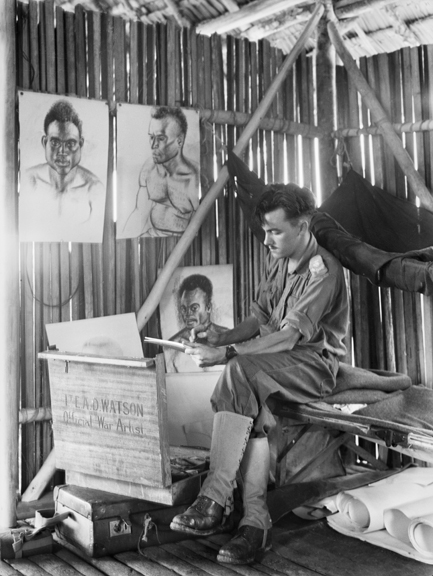
Lieutenant E. A. D. Watson, Official War Artist of the Military History Section, Headquarters Australian New Guinea Administrative Unit, Kakakog, New Guinea. 6 April 1944. Australian War Memorial 072065.
In 1941 Watson had written to the Commonwealth Art Advisory Committee declaring his interest in being a war artist, but his request took several years to be realised. Watson enlisted in July 1942 and was assigned to the 4th Camouflage Training Unit, then transferred to the Military History Section in August 1943.ii He became an official war artist with the rank of Lieutenant in November 1943 and was sent to Townsville to begin his commission. On the way he stopped in Sydney to document the activities at the Sydney Graving Dock. He served as a war artist with the Military History Section for the last two years of the war and most of 1946, covering activities in Australia, New Guinea and Borneo, and creating close to 200 drawings that became part of nationally important collections like the Australian War Memorial. His drawings and paintings included portraits of soldiers, officers, Indigenous people and even captured moments like “Surrender on Corvette', 1946. Two of these works provide excellent examples of his approach to documenting World War II.
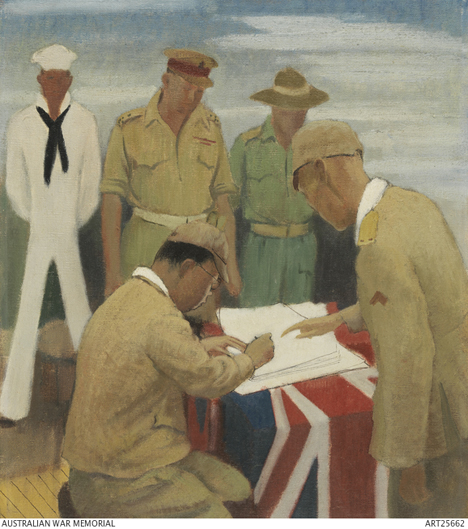
Japanese forces in Borneo are pictured surrendering to the 9th Australian Division. This was one of many such ceremonies across the region in which soldiers, prisoners, civilians, and territories passed from Japanese to Allied control. Standing L-R: unidentified United States Navy seaman, Brigadier T C Eastick, CMG, DSO, Commanding Force, unidentified Australian soldier, unidentified Japanese soldier, seated: Major General H Yamamura, Commanding of Japanese forces in area signing surrender document on board RAN corvette HMAS Kapunda. Painted by Douglas Watson in 1946. Australian War Memorial, ART25662
The above painting in oil with pen and ink captures both Watson’s style and approach to being an official war artist. He created the work in several phases, using different mediums depending on the circumstances. He initially created a sketch while Major General H Yamamura was signing paperwork under the watchful eyes of Brigadier T C Eastick, a U.S Navy seaman, and an Australian and Japanese soldier. As there was only a limited time for him to capture people, Watson prioritized the commanding officers while on board RAN corvette HMAS Kapunda. The painting was finished in his studio in Sydney in 1946 and handed over to the Australian War Memorial for their collection.
In another example, one of Watson's portrait sessions of Private James Meredith, was caught on film in 1945 at the 13 Australian General Hospital.iii Like many of his sketches, drawings, or paintings, Watson captured the everyday of enlisted men, emphasizing their humanity amid the backdrop of war. He was discharged in 1946. Hazel de Berg recorded an interview with Douglas Watson in 1962 which is now part of the National Library’s collection and available to listen online. In part of that interview he recalls his war artist duties:
Well this [being an official war artist] then gave me a wonderful experience, working mainly with the 7th and 9th division in some of their New Guinea campaigns. Going through campaigns recording on small notebooks with me, jotting down anything that I thought was important. These all were going to the archives: the War Memorial in Canberra. Then when we went through the campaign, bringing our material back to headquarters. My headquarters at the time was Sydney. And working on these paintings here.
Douglas Watson, 1962 iv
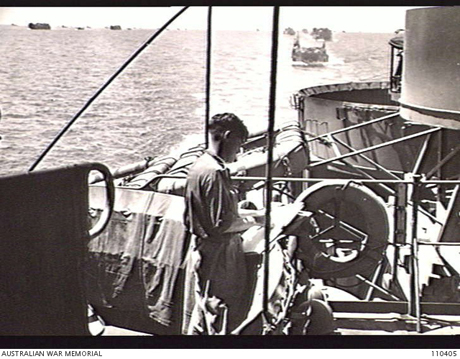
‘At sea. A section of the convoy travelling to Balikpapan for the Oboe 2 operation. Lieutenant E. A. D. Watson, Official War Artist, 7 Military History Field Team, shown standing in bow of landing ship, sketching’ 29 June 1945. Australian War Memorial 110405
After the war, Watson returned to Sydney. He spent until August 1946 finishing up his war paintings and drawings. Between 1945 and 1957, he worked at a studio located at 209 George Street while residing in his father’s apartment in the residential apartment building Woollahra House, 6 Longworth Avenue, Point Piper. Albert A Watson, Douglas’ father, rented the Point Piper apartment and Douglas used that address as his base during and after the war.v During his first year back, Watson had also begun to create new works for gallery shows and a variety of prizes. Douglas was officially discharged from the army on 7 August 1946 after completing the artworks begun overseas.
During the dozen years after his discharge, Douglas created, exhibited and sold works in London, Sydney and Melbourne. He travelled to various galleries in Europe between 1947 and 1951, including the National Gallery of London and was accepted for the Royal Academy (London) exhibition in 1950.vi Watson particularly sought European artists within the Italian Renaissance, Dutch and Spanish schools.
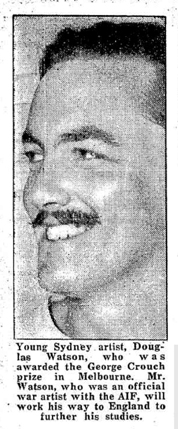
"No title" Wellington Times, 3 April 1947 p 16.
After the war, Watson was the finalist or winner of seven different prizes - in 1947 he won the Crouch Art Prize in Ballarat. vii The following excerpt from a contemporary newspaper indicates his abilities as a successful Australian artist, taking the £100 prize over Melbourne artists.
Commenting on Mr. Watson’s winning entry, an oil of the interior of an art gallery entitled “In the Gallery,” Professor Burke said that it was admirable in color and design, and showed keen observation of character.
"Crouch Art Prize: Sydney Artist Successful” The Age, 21 March 1947, p 3
A newspaper excerpt of another show indicates the extent of Watson’s creativity while abroad – he later transferred the techniques and perspectives gained in Europe to Australian subjects and landscapes.
Douglas Watson explores the Utrillo area of Paris in his exhibition now at the Macquarie Galleries and has some flattering, nostalgic things to say about the city, particularly about the Sacre Coeur and the Place de Tertre. Even London has something to offer, in the London Backyards, and when the artist turns to paint “Windmills” he enters a more intensive creative phase. No. 19, Bages, takes the simplified lines of the other landscapes a degree further, building up a pleasant combination of forms and soft colours. Sacre Coeur is most refreshing in its neat, ordered gaiety, and if we are naturally led to think again of Utrillo, that is no reason why we should make any comparison unfavourable to Mr. Watson. It's only too obvious how much he has felt the spirit of the city and we can take delight with him in those rooftops and old streets of Montmartre and the crumbling Colours of the walls. This fine exhibition remains open until 29th September.
"At Sydney Galleries. Douglas Watson" Le Courrier Australien 19 September 1952, p 5. viii
Watson’s father died in 1958, the same year that Douglas and his sister Madge purchased 39 Etham Avenue, Darling Point.ix Madge was a headmistress at the Double Bay public school in the 1950s. The house on Etham Avenue was the final residence for both siblings.
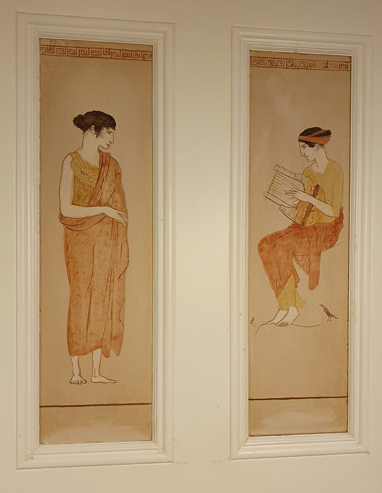
Door panels painted by E A D Watson at 39 Etham Avenue, Darling Point
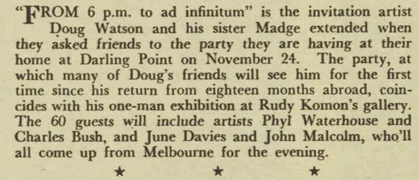
'Social Roundabout', December 1, 1965. The Australian Women's Weekly p. 10.
Madge died in 1967 and was interred in the Waverley Cemetery on the 5th of September, 1967. E A D Watson’s final resting place is beside his sister. In October of 1972, following Douglas Watson’s death, there was an auction of antique furnishings and objects d’art from their home.x
Douglas Watson taught at the Alexander Mackie College, Sydney from 1962 to 1972, and was well-known as an artist, collector and lecturer. In his later years, Watson explored the texture of painting and was fascinated by the art of children, particularly his students.
A touch of humour, I think, is a very necessary thing these days, particularly in painting.
Douglas Watson, 1962
The Alexander Mackie College is now part of the University of New South Wales and material he created or collected remains in the collections of the UNSW archives. There are figurines, masks, shields, pottery, furniture, swords and carvings from Australia, Papua New Guinea, Bali, Europe, Africa, and the Americas. During his time as a lecturer, Watson was also asked to judge artistic works in Rabaul, Papua New Guinea in 1966.xi The trip enabled him to visit an area he was unable to experience two decades earlier while serving in World War 2.
An engaging ‘on-camera’ ability made him a rewarding, demanding, unconventional talker, lecturer and advisor and, if he gave you his friendship, you could not but be influenced by his enthusiasms and warm interference.
Charles Bush, 1972 xii
Awards
Winner of the NSW Travelling Scholarship, 1939.
Winner of the Wynne Prize, 1942 and 1945. Finalist of the Wynne Prize, 1941 and 1961. The Wynne Prize is awarded annually for 'the best landscape painting of Australian scenery in oils or watercolours or for the best example of figure sculpture by Australian artists’.xiii
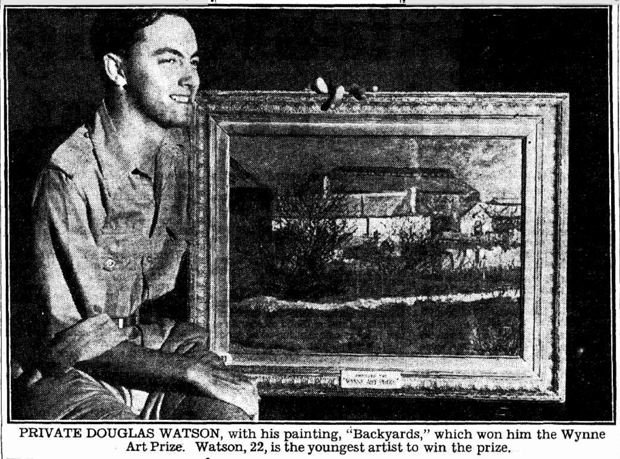
'Soldier wins Art Prize' Daily Telegraph, 23 January 1943. 'Private Douglas Watson with his painting, “Backyards” which won him the Wynne Art Prize. Watson, 22 is the youngest artist to win the prize'.
Finalist of the Archibald Prize eleven times: 1939 (Self Portrait), 1941, 1942, 1943 (Self Portrait & Dispatch rider Sgt Rex Beggs), 1945, 1952, 1957, 1959, 1966, 1967, 1968 The Archibald Prize is awarded annually to the best portrait, 'preferentially of some man or woman distinguished in art, letters, science or politics, painted by any artist resident in Australasia’.
Finalist of the Sir John Sulman Prize six times: 1942, 1943, 1954, 1956, 1957, 1960 “The Sulman Prize is awarded for the best subject painting, genre painting or mural project by an Australian artist.”xiv
Winner of the George Crouch Art Prize, Ballarat, 1947 for ‘In the gallery’.
Winner of the Bathurst Prize, 1970.
E A Douglas Watson was a prolific Australian artist, collector and lecturer. He sketched and painted both landscapes and portraits, travelling the world for new inspiration. He was born in Sydney and lived in Woollahra for half of his life, in the suburbs of Point Piper and Darling Point. Very early in his career, he won several major prizes and was an official Australian war artist in WWII. Watson travelled extensively across Australia, the Pacific, and Europe and his art was heavily influenced by those experiences. His works remain in the collections of the National War Memorial, the National Gallery of Victoria, the Art Gallery of NSW, the University of NSW, and the National Gallery of Australia. He lectured extensively to students of art as well as the general public through lectures, magazine articles and even on television. Watson passed away suddenly on October 17 in 1972, 'beloved brother of Madge (deceased), Alex and Lorna'.xv His artistic influences were fondly remembered by his friend and contemporary, artist Charles Bush.
“His early work with its restrained colour and sensitive textures owed more to Rembrandt, Degas, Vuillard and Wilson Steer than the local painters of the time; even so he was among the very earliest collectors of Dobell, Fairweather, Molvig and Passmore, to name but a few.”
Charles Bush, 1973 xvi
Australian War Memorial biography of Lieutenant Edward Albert Douglas Watson. https://www.awm.gov.au/collection/P7439.
Bush, Charles “Douglas Watson: a personal reminiscence [Obituary]” Art and Australia, v.10, no.3, Jan 1973, p.235.
Watson, Douglas. Douglas Watson interviewed by Hazel de Berg in the Hazel de Berg collection [sound recording], 1962 National Library of Australia. http://nla.gov.au/nla.obj-214286702
Watson, Edward Albert Douglas, Papers of Edward Albert Douglas Watson regarding his career as an artist, c1940-1966. Call Number: MLMSS 2357/Box Y4939, State Library of NSW, Special Collections.
University of NSW archives, Art Collection Catalogue of the Alexander Mackie College of Advanced Education, Series 029945, Part A: Selection of E. A. Douglas Watson 1962-1972 pg 3-20.
Footnotes
i Bush, Charles “Douglas Watson: a personal reminiscence” Art and Australia, v.10, no.3, Jan 1973, p.235.
ii WATSON EDWARD ALBERT DOUGLAS : Service Number - NX191007 : Date of birth - 13 Jun 1920 : Place of birth - SYDNEY NSW : Place of enlistment - MELBOURNE VIC : Next of Kin - WATSON ALBERT, National Archives of Australia, Series B833, NAA: B883, NX191007.https://recordsearch.naa.gov.au/SearchNRetrieve/Interface/ViewImage.aspx?B=5586732
iii His Highness the Rajah of Sarawak, Sir Charles Vyner Brooke's Birthday celebrations, Kuching & scenes in 9 Division released POW camp & visit of Lady Mountbatten to 2/1 Australian Casualty Clearing Station FILM, War Memorial https://www.awm.gov.au/collection/C190488 from 2:19-2:33 of the 3:28 film from 1945.
ivhttp://nla.gov.au/nla.obj-214286702 Douglas Watson interviewed by Hazel de Berg - the interview is 10 minutes of Watson describing his whole, artistic life.
v NSW Department of the Valuer General, Valuation List 1949 (Valuation No 456) & 1956. WATSON EDWARD ALBERT DOUGLAS, NAA: B883, NX191007.
vi Our art in Royal Academy (1950, April 28). The Argus (Melbourne, Vic. : 1848 - 1957), p. 4. http://nla.gov.au/nla.news-article22825392
vii George Crouch Prize for contemporary art ran from 1927 till the 1970s. Established by Federal MP Richard Crouch, a native of Ballarat and son of an early pioneer, as an acquisitive art prize in memory of his father, the Crouch Prize was for many years one of the most prestigious art prizes in the country. Source: Art Gallery of Ballarat.
viii “At Sydney Galleries” Le Courrier Australien (Sydney, NSW : 1892 - 2011) 19 September 1952: 5. Web. 30 Sep 2020 http://nla.gov.au/nla.news-article166979354.
vix NSW Department of the Valuer General, Valuation List 1958, p 354.
x Watson, Douglas (Edward Albert Douglas) & Geoff K. Gray Pty. Limited Auction sale of antique and period furnishings, porcelains, glass, silver, oriental porcelains and persian rugs at the residence, 39 Etham Avenue, Darling Point 10.30 a.m. Tuesday, 9th October : under instructions from the executors in the estate of the late E.A.D. Watson. Geoff K. Gray, [Rosebery, N.S.W.], 1973.
xi University of NSW Archives, Art Collection Catalogue of the Alexander Mackie College of Advanced Education, Series 029945, Part A: Selection of E. A. Douglas Watson 1962-1972 p 3-20.
xii Bush, Charles, p.235.
xiii https://www.artgallery.nsw.gov.au/prizes/wynne/
xiv https://www.artgallery.nsw.gov.au/prizes/sulman/
xv Sydney Morning Herald Thursday 19 October, 1972 p 36.
xvi Bush, Charles, p.235.
New plaques are added based on nominations from the community, which are then assessed against selection criteria and researched by a Local History Librarian.
Find out more and nominate a person or event for a plaque.